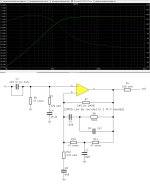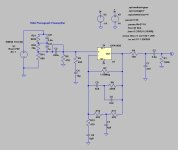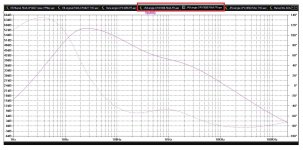When you replace the 2.2 uF capacitors at the input with wires, you get second-order Butterworth filtering down to 1.1 Hz and first order below 1.1 Hz. Maybe that is good enough as well.
Maybe a bypassing pin should be worth installing alongside the cap. Easier to see the results with and without cap.
Attenuation @ 3Hz, which is the point I'm interested in, is just -28dB without bypass and -30dB with bypass, which I would consider negligible.
They move down, as it should, when using a 220n input cap, going to -43dB @ 3Hz. But I wonder what else is affected.
Attenuation @ 3Hz, which is the point I'm interested in, is just -28dB without bypass and -30dB with bypass, which I would consider negligible.
They move down, as it should, when using a 220n input cap, going to -43dB @ 3Hz. But I wonder what else is affected.
I'm trying that change. thanks Marcel.When you replace the 2.2 uF capacitors at the input with wires, you get second-order Butterworth filtering down to 1.1 Hz and first order below 1.1 Hz. Maybe that is good enough as well.
Is it what it should be, Marcel?
Well not really. Schematically it's correct but the 0dB line is not right. You have to remember that @20hz the gain is officially up by +19.3dB from that of the mid-band, 1kHz, 40dB, aka 0dB. So, for example @3Hz you are not rolled-off by 28dB. You are down -28dB from +19.3dB or about -8dB wrt 1kHz.. You are showing 0dB as +19.3dB. If you harmonize my proto's FR graph with your numbers they pretty much agree at or near 20Hz and below - if you correct by ~20dB. Or have I misunderstood something..? Perhaps your graph is a RIAA variance graph?Yes, that looks about right.
Attachments
I assume that @carlmart applied a reverse RIAA correction somewhere in his simulation and normalized everything to 0 dB at 1 kHz, so that you only see the high-pass transfer. If this were the transfer of the whole circuit without inverse RIAA correction or normalization, it would be very wrong: no gain, no RIAA correction.
If you remove the inverse RIAA network, run a sim and set the 1kHz gain at 0dB do you get a FR that looks like what I got here at home with the real deal?
Did you choose the 2nd or 3rd-order option? Looks like my 2nd-order. In fact your sim and my actual 2nd-order scope results are nigh duplicates.This FR curve is what I get removing the inverse RIAA network.
Second order with shorted input capacitor and about 40 dB of gain at 1 kHz, according to the schematic of post #588.
JRA's should have twice the gain, and as long as the input coupling capacitor is still there, it should not have the slight bend in the curve around 1 Hz.
JRA's should have twice the gain, and as long as the input coupling capacitor is still there, it should not have the slight bend in the curve around 1 Hz.
Do you see a bend in my plot from #586 with the 2.2uF in-place? What bend?JRA's should have twice the gain, and as long as the input coupling capacitor is still there, it should not have the slight bend in the curve around 1 Hz.
No, I don't, but I do see that the subsonic part of the curve of post #590 is not entirely straight, it slightly bends at very low frequencies (order of 1 Hz). That's a difference between the measured and simulated curves, and it is as expected, it's simply the effect of the shorted input capacitor in carlmart's simulation.
I used the wrong verb tenses in post #592, what I should have written is:
JRA's has twice the gain, and as the input coupling capacitor is still there, it does not have the slight bend in the curve around 1 Hz.
JRA's has twice the gain, and as the input coupling capacitor is still there, it does not have the slight bend in the curve around 1 Hz.
If you look at the upper right hand of the diyaudio toolbar, you may see a magnifying glass. Clicking on that invokes the search function, and typing in OPA828 yields this as the first thread:
And this as the second:
By now it has been a while since OPA828 (and OPA2828) were released. Any detailed comparison done (in the context of audio) to the opamp, OPA627, that they are supposed to replace? Thanks!
And this as the second:
Has anyone tried the OPA828 as part of a RIAA preamp?
Having FET input and being reasonably low noise, it looks as a good candidate.
Having FET input and being reasonably low noise, it looks as a good candidate.
- carlmart
- Replies: 38
- Forum: Analogue Source
I didn't remember I had asked myself this very same question.
It really seems that nobody felt an interest on swapping opamps for this project.
It really seems that nobody felt an interest on swapping opamps for this project.
carlmart. Yes. You've be at this for 5-years. Asking for op-amp models, LTspice simulations ad nauseam, searching for and quoting topologies and techniques but you never build anything. Doing a quick search here I see the top three op amps being 1) BB 627; 1a TI 827; and 2) BB 2107 There are your choices. And maybe a BB 1641/42 difet.I didn't remember I had asked myself this very same question.
It really seems that nobody felt an interest on swapping opamps for this project.
Has anyone tried the OPA828 as part of a RIAA preamp?
Having FET input and being reasonably low noise, it looks as a good candidate.
Having FET input and being reasonably low noise, it looks as a good candidate.
- carlmart
- Replies: 38
- Forum: Analogue Source
Stimulations will tell you nothing more. The 627 was introduced by BB in 1989. It was Hi-$$ then as is now. It is still in the general "best of" conversations and forum chatter. (2008+) It is still hi-$$ b/c of curiously continuing demand; TI has to produce it on old fab lines - and they don't like that. Don't quote me.
But you have OPA627s in DIP8! So go for it. But, don't go for an everlasting search for "simulations". Go for the opinions of critical listeners. JMHO.
WHS. If you end up with something that initially sounds bad or oscillates, what of it? Play around with bypassing, different parts, whatever, and in the process you'll learn from what doesn't work and what does.
When I was starting out a wise old tech told me: "You're gonna blow something up. Guaranteed. So long as you took all due precautions, comb the capacitors out of your hair and start over. It's not the end of the world, it's a few bucks gone up in smoke. Pick yourself up and try again."
There's such a thing as analysis paralysis. Some day you gotta pick up the soldering iron and make a fool of yourself. This is the way to knowledge.
When I was starting out a wise old tech told me: "You're gonna blow something up. Guaranteed. So long as you took all due precautions, comb the capacitors out of your hair and start over. It's not the end of the world, it's a few bucks gone up in smoke. Pick yourself up and try again."
There's such a thing as analysis paralysis. Some day you gotta pick up the soldering iron and make a fool of yourself. This is the way to knowledge.
- Home
- Source & Line
- Analogue Source
- OPA1656 Phono Preamp: Split from OPA1656 thread


